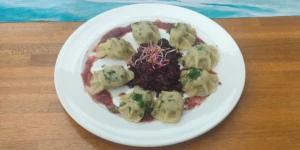
Pierogi z gęsiną - Goose dumplings (Kashubian‑Pomeranian)
Jump to recipe
In Kashubia and Pomerania, goose pierogi are a regional variant of the more familiar meat pierogi, distinguished by the use of locally bred goose. They are made primarily during the St. Martin's Day season (around November 11th), when a plump goose was traditionally eaten - a symbol of prosperity and abundance. These pierogi are served with onions and goose fat cracklings, and are often served at regional festivals - in Swołowo near Słupsk, the annual "On St. Martin's Day, the best Pomeranian goose" is held - a feast attracting thousands of people interested in local cuisine, including goose pierogi.
Goose breeding in the Pomeranian-Kashubian lands dates back to the Middle Ages - Kashubians kept local breeds (Pomeranian and Kartuzy), prized for their lard, feathers, and meat. In the 19th century, Poland was the leading producer of goose meat in Europe, with millions of goose being shipped to Prussia, and Pomerania serving as a hinterland, including through geese exported to Berlin. The tradition of eating goose meat has therefore been around for a long time.
Recipe informations:
Ingredients for the filling
- 350-500g cooked or roasted goose meat (breast, leg)
- 1 large onion, sautéed in goose fat (2 tablespoons)
- 1-2 tablespoons breadcrumbs
- ½ cup cold water
- salt, freshly ground pepper, ½-1 teaspoon marjoram
Ingredients for the dough
- 2 cups all-purpose flour (+ optional ½ cup for dusting)
- ½ teaspoon salt
- approx. ⅔ cup hot (not boiling) water
